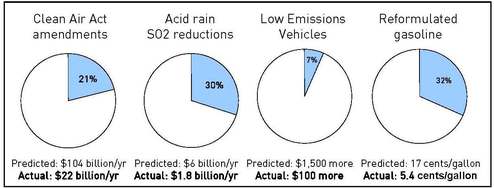The transition to clean energy, reducing our dependence on dangerous foreign oil and protecting our environment will cost less than some would have you think.
In April, the EPA estimated that the American Clean Energy and Security Act would cost households less than the cost of a postage stamp each day, roughly $100-$140 per year. Since then, the EPA estimates the changes to the bill will reduce the cost of allowances by 10%, which will in turn lower the actual cost to households.
The EPA is not alone in forecasting only nominal impacts from the bill. Numerous academic and government studies have found that climate legislation has a nearly indistinguishable impact on GDP.
So what to make of predictions that climate legislation will have devastating impacts on U.S. businesses and the economy? The U.S. Chamber of Commerce compares regulating global warming pollution to “suicide bombing the American economy.” The Heritage Foundation makes its own doom and gloom claims, saying the American Clean Energy and Security Act “promises job losses” and “income cuts.” (Rebuttals to several such economic forecasts can be found at ww.CO2MediaGuide.org.)
But have such predictions been borne out in the past? With decades of environmental regulation and cost data behind us, a number of experts have asked and answered this question. As Frank Ackerman of Tufts University summarizes in his paper “The Unbearable Lightness of Regulatory Costs,”
“The evidence is clear: the costs of environmental protection are much more often overestimated, rather than underestimated, in advance…One study found that compliance costs for environmental regulations were overestimated in advance in 11 out of 12 cases (Hodges 1997). Another study found that advance cost estimates for environmental compliance turned out to be more than 25 percent too high in 14 out of 28 cases, while they were more than 25 percent too low in only 3 of the 28 cases (Harrington et al. 2000). A study for Environment Canada and the Ontario Ministry of Energy, Science and Technology, focusing specifically on the costs of controlling chlorinated substances, confirmed that overestimation of regulatory costs is more common than underestimation (Cheminfo Services 2000).” [emphasis added]
Environmental Defense Fund presents some clear examples in a 2007 letter to Congress:

A 1997 Economic Policy Institute report detailed a number of cases where environmental regulations were overestimated. The average overestimate on this list is 600%:

It isn’t that surprising that despite thirty years of claims about economic doom and gloom being proven false, industry and opponents of climate legislation continue to trot such claims out. What is surprising is anyone listens to them anymore.
[Original post at http://switchboard.nrdc.org/blogs/paltman/a_quick_survey_of_exaggerated.html]



